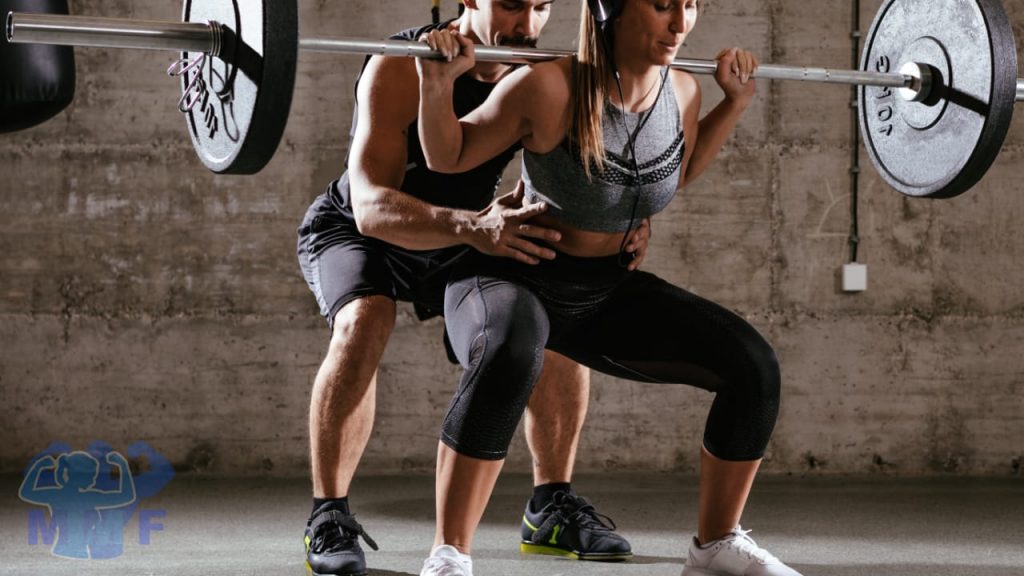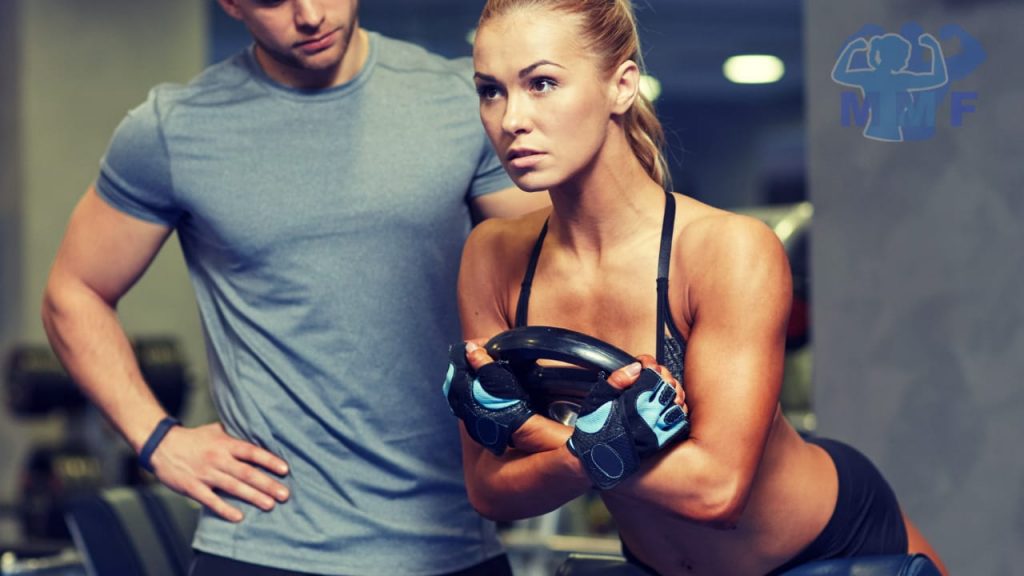Most of us think of static bodyweight exercises when we think of core work. But to develop a really powerful core you must incorporate resistance training and these are the best weighted core exercises.
What Is Your “Core”?
Your body’s core is the area around your trunk and pelvis. Weak core muscles leave you susceptible to poor posture, muscle injuries, and lower back pain. Likewise, strong core muscles, can improve your posture, stability, overall strength, and reduce your risk for lower back pain and injuries.
Best Weighted Core Exercises
The following exercises are some of the best-weighted core exercises and collectively will aid you in the development of strength in your body’s core.
Barbell Deadlift

The Deadlift becomes one of the best weighted core exercises by working the target muscle Erector Spinae, with Synergist muscles Gluteus Maximus, Adductor Magnus, Quadriceps, Soleus and Stabilizing muscles Hamstrings, Gastrocnemius, Trapezius Middle and Upper, Levator Scapulae, Rhomboids, Rectus Abdominis, Obliques.
Deadlift Exercise Procedure For Strengthening Your Body’s Core
Perform the Deadlift by pushing through the heels and bringing your hips forward, not by pulling back with your lower back. If you Deadlift correctly, you’ll feel most of the stress in your upper back, glutes, and hamstrings.
- Stand with feet approximately shoulder-width apart with toes slightly pointing out. Put your shoulder-blades directly over bar and shoulders in front of the bar. Grip the bar with a “reverse grip” (one palm faces you, the other palm facing away).
- Push from the heels and pull the bar up in a straight line.
- Keep the bar in contact with your body during the whole Deadlift, rolling the bar over your shins & thighs.
- Bring your hips forward by pushing from the heels and squeezing your glutes hard.
- The Deadlift ends when your knees and hips are locked.
- Bring the weight down, controlled but not slow, while keeping your chest up, shoulders back and looking forward.
- Keep the bar in contact with your thighs until it reaches knee level.
- Flex at the hips first to return the bar below knee level. Then bend at the knees until the bar is on the floor.
Tips: To minimize risks of injuries when completing Deadlifts, make sure you follow the correct Deadlift procedure. While performing the Deadlift, make a big chest by keeping your chest up and pulling your shoulders back. Keep this position at all times, and your back will never be able to round. Practice with lightweight until you have mastered the correct Deadlift form and procedure before moving to a heavier weight.
Barbell Straight-Leg Deadlift
Straight Leg Deadlift is one of the best weighted core exercises if you do it right. Once you have the movement down this will be one of the best weighted core exercises in your routine for strengthening the body’s core.
The Target muscle use while performing the Straight Leg Deadlift is Erector Spinae with Secondary Muscles (synergist/stabilizers) Hamstrings, Gluteus Maximus, Adductor Magnus, Trapezius (Upper, Middle, Lower), Latissimus Dorsi, Levator Scapulae, Rectus Abdominis, and Obliques.
- Pick up the barbell off the ground using the power from your legs (not your back), pull your shoulders back, stick out your chest and arch the back slightly with eyes looking forward.
- Space your feet slightly narrower than shoulder-width apart and hold the bar with a “reverse grip” (one palm faces you, the other palm facing away) just outside of your legs.
- Keeping a slight bend in your knees, bend forward at the waist and lower the weight toward the ground.
- Lower the weight down until you feel a full stretch in your hamstrings.
- Pull the weight back up into the standing position but stop just short of being fully erect.
- Continue the motion until you have reached muscular failure.
- Rest and repeat.
Tips: It is essential that you do not round out your lower back at any point while performing Straight Leg Deadlifts, but instead maintain a slight arch at all times. When completing Straight Leg Deadlifts keep your back flat, focus on sticking your butt out and keeping the bar close to your body. You must also remember to keep a slight bend in your knees as you perform the Straight Leg Deadlifts as this will keep the tension on the hamstrings and minimize your risk of injury.
Squats

The squat is the king of all exercises, working over 256 muscles in one movement! Squats are also a significant power movement exercise. With Squats as a big power exercise and working numerous muscles, it’s no wonder that it’s also one of the best core strengthening exercises out there.
Target muscle use while performing Squats are the Quadriceps with Secondary Muscles (synergist/stabilizers), Gluteus Maximus, Adductor Magnus, Soleus, Hamstrings, Gastrocnemius, Erector Spinae, Rectus Abdomimis, and Obliques.
Squats Exercise Procedure for Strengthening the Body’s Core
- Setup for the Squats by setting the barbell to just below shoulder height on the rack and loading the weight you want to use.
- Stand under the bar with your feet at about shoulder-width apart with your toes pointing slightly outward and rest the bar on your lower traps and rear shoulders.
- Take your hands over the back and grip the bar with a wide grip for stability.
- Bend at the knees and straighten your back in preparation to take the weight off the rack.
- Keep abs tight, back straight and eyes up, push up through the legs and take the weight off the rack.
- Take a small step back and stabilize yourself.
- Keep your eyes facing forward and slowly lower your body. As you lower your body don’t lean forward, your buttocks should come out and drop straight down.
- Squat down until your thighs are parallel with the floor, then slowly raise your body back up, pushing through your heels. Do not lock the knees out when you stand up.
- Repeat the movements until you complete your desired number of reps.
Tips: You can make many easy mistakes while performing Squats. As such, you must have your technique down before you attempt to squat with heavyweights. You should start outperforming Squats by using very light weights until you get a good feel for the lift and can execute it with perfect form. If you perform Squats correctly, you should not feel any pain in your lower back. Lower back pain is usually a sign that you are not using correct form when performing Squats, and your core is weak. It’s recommended not to take the Squat exercise to total failure since you could easily hurt yourself.
Cable Kneeling Crunch

Target muscle use while performing Cable Kneeling Crunch are Rectus Abdominis with Secondary Muscles (Synergist/Stabilizers), Obliques, Iliopsoas, Tensor Fasciae Latae, Rectus Femoris, Sartorius, Latissimus Dorsi, Teres Major, Deltoid Posterior, Triceps Long Head, Rhomboids, Trapezius Lower, Pectoralis Major Sternal, Pectoralis Major Clavicular, Pectoralis Minor and Serratus Anterior.
Cable Kneeling Crunch Procedure for Building a Strong Core
- Facing cable tower, kneel below a high pulley and grab cable rope attachment with your hands.
- Place wrists against head, flex hips slightly and allow the weight to hyperextend the lower back.
- With hips stationary, flex your waist, so elbows travel toward middle of thighs while exhaling.
- Pause and return to starting position, while inhaling, with keeping tension on the abdominals.
- Repeat.
Tips: Use lightweight while performing Cable Kneeling Crunch until you have the full range of movement with proper extension and contraction completed. While performing the Cable Kneeling Crunch exercise your butt should stay touching your heels without pivoting at the hips and with concentrating on crunching your abs in. As you increase the weight with Cable Kneeling Crunch, it may be more comfortable to rest the rope and hands-on shoulders.
Incline Twisting Situp
By adding weights and increasing the incline, the Incline Twisting Situp becomes a solid core exercise. The added weight and steeper angle increase the difficulty of the stomach exercise, and it also engages the obliques and works the entire core. You may have trouble performing Weighted Incline Twisting Situp because it is an advanced exercise. Although when mastered, it becomes a premier core exercise by working for the whole abdominal muscle group.
Muscle groups worked by Weighted Incline Twisting Situp are Obliques as the Target muscle, iliopsoas, Tensor Fasciae Latae, Rectus Femoris, Sartorius, Rectus Abdominis and Tibialis Anterior as Secondary muscles (synergists/stabilizers).
Weighted Incline Twisting Situp Procedure for Building a Strong Core
- Hook your feet under the foot braces and lie on a bench with feet raised higher than your head and knees at a 90-degree angle.
- Grasp a plate across the chest or behind your head with both hands.
- Raise upper body off of the bench and flex the abdominals while twisting to the right or left.
- Slowly return to the original position.
- Repeat and twist to the opposite side.
Tips: Weighted Incline Twisting Situp can be done with or without weight, and the weight can be adjusted, and the bench can be elevated to increase resistance.
Weighted Hyperextensions

Hyperextension is an excellent exercise for strengthening the lower back. Strong lower back muscles will enable you to have a stronger core. Strengthening the lower back along with abs will you virtually eliminate all back pain associated with having a weak core. Hyperextensions are rated one of the best isolation exercises for targeting the lower back and strengthening your body’s core.
Hyperextensions target Erector Spinae muscles directly with Secondary muscles Gluteus Maximus, Hamstrings and Adductor Magnus. If you hold the weight behind the head Spienius and Levato Scapulae muscles are activated as additional stabilizers.
Weighted Hyperextensions Procedure for Developing a Strong Core
- Lie face down and position your feet firmly on the platform tucking your ankles securely under footpads.
- Start with your body in a straight line. Cross your arms in front of you and hold a weight to your chest (optional holding weight behind the neck).
- Bend at the waist and lower your body towards the ground until you reach about 65-75 degrees.
- Pause briefly at the bottom and then raise yourself back up to the starting position where your back is in a straight line with your lower body.
- Repeat.
Tips: While performing Hyperextensions, focus on keeping the tension on your lower back throughout the entire motion. To get the best results you should perform Hyperextensions with slow and controlled movements. Do not round your back. You should keep your back flat while performing Hyperextensions. When coming back to the starting position, do not arch your back past a straight line.
Honorable Mentions
There are numerous weighted core exercises that can be the best weighted core exercises for you. Remember to change up exercises in your routine frequently. Additionally, everyone’s body is different and the exercises that work best for you may not be the ones for someone else. So here are some additional weighted exercises you can do for you core: Barbell Push Crunch, Weighted Hanging Leg-Hip Raise, Weighted Incline Crunch, Dumbbell Side Bend, Weighted Lunges, Barbell Front Squat, Weighted Hack Squat, Weighted 45-degree Hyperextensions.

